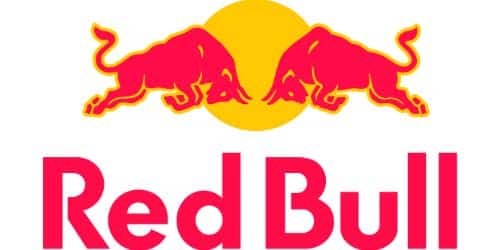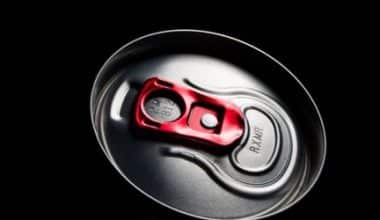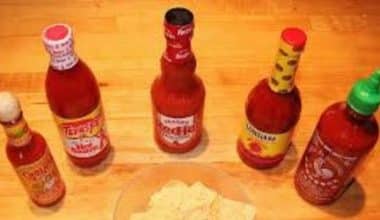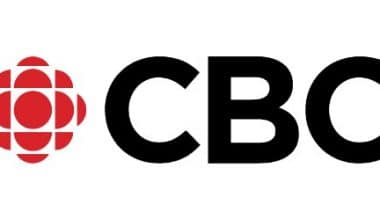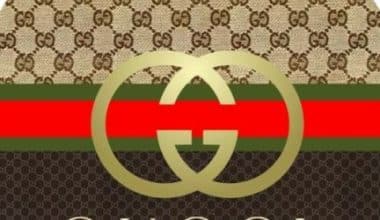The energizing non-alcoholic beverage known as Red Bull was invented in Austria in 1987. Red Bull is now the world’s most well-known energy drink brand, and its goods are available in supermarkets everywhere. Each year, the corporation sells billions of cans. The Austrian beverage firm Red Bull GmbH produces, markets, and owns one of the most well-known and successful energy beverages in the world, Red Bull. Each year, it sells more than 4.5 billion cans. As of 2011, Red Bull GmbH made €4.253 billion a year and had more than 8,300 employees worldwide. Read on to learn about the branding of Red Bull and the story behind its logo.
Red Bull Logo
The Red Bull logo has a long history that began in 1987. At that point, Dietrich Mateschitz, the company’s owner, tried the Thai energy drink “Krating Daeng” (which translates to “red bull” in English). It amazed him that the new product’s concept and logotype almost immediately came to him.
The two red bulls in the logo are fighting in front of a gold spot meant to represent the sun. The Red Bull logo is among the most well-known and easy-to-recognize ones in the drinks business. Its two red bulls charging at each other in front of a yellowish gold circle are known as the “red and gold” logo.
The logo represents qualities like power, quickness, aggression, and vigor. The bulls stand for strength and bravery, while the blue and silver elements in the background stand for excellence and intelligence. The red and yellowish gold in the Red Bull logo represents greatness, emotion, and grandeur.
Red Bull’s catchphrase, “Red Bull gives you wings,” sparked a $13 million class action lawsuit in 2014. The company was accused of misleading its customers by telling them they would be able to focus better and think more quickly. Red Bull has the same amount of caffeine as a cup of coffee, or even less, even though the ads for the brand say it gives you more energy. Red Bull Studios are unique recording studios that musicians worldwide can use throughout the day. For this project, a digital creative agency called Momkai used regional themes to develop different versions of the Red Bull logo. Interviews with performers were held in front of the logos.
Why Do Red Bull Logos Function?
#1. The Logo Is Special
A distinctive trademark in the beverage sector is the Red Bull logo. The sun disc, the aggressive bulls, and the unique wordmark set the logo apart from the competition. Additionally, the logo is easily recognizable thanks to these standout graphic components.
#2. The logo can be read:
The Red Bull logo is understandable from a distance and on many surfaces. With this in place, customers can easily read, recognize, and comprehend the logo. The trademark’s legible bespoke typography confirms that it satisfies this crucial condition.
#3. The Logo Is Recallable
Impressive logos have a straightforward time sticking in people’s minds. The Bull’s logo is distinctive. It includes memorable design elements that help it stand out. Potential or present customers can vividly recall the legendary Red Bull logo.
#4. The Logo Is Traditional
Less is more! Please accept it as the truth in branding rather than see it as a cliché. For example, the Red Bull logo gives people a lot of chances to recognize and remember what it looks like. The designer did a great job of capturing the brand’s personality with just three design elements.
#5. The Logo Can Be Scaled:
Simple layout logos are supported by contemporary marketing methods. So the Red Bull emblem is flexible while having fewer visual components. This means that its design is simple, which makes it easy to use on different advertising platforms. In other words, the Red Bull logo can flow regardless of the channel.
Symbol and Shape of the Red Bull Logo
#1. The Bulls
The red bull logo stands for integrity at work. They reinforce the Red Bull brand’s veiled feelings. A bull represents power, assurance, stability, and endurance. They represent farming, teamwork, fertility, and helpfulness in various civilizations. The two bulls also depict the results of consuming the Red Bull beverage. This is unquestionably a carefully selected graphic element.
#2. An A-Round:
The golden circle is typically perceived as the sun. It is regarded as the earth’s ruler in the majority of traditions. This cosmic component stands for influence, life, light, and energy. It also represents expansion, strength, good health, and enthusiasm. Last but not least, the sun represents completion and infinity.
Red Bull Logo Color Scheme
#1. Color Red
The Red Bull logo’s prominent color is red. It emphasizes the wordmarks and the animals’ frightening nature. This dominant hue denotes strength, passion, and love. Additionally, it can inspire bravery, risk, and willpower. The brand should choose red since it stands for activity, energy, and passion.
#2. Gold Color:
The next crucial hue for conveying the emotion of the logo is gold. The artist used it to portray the bulls’ surroundings and general shapes. Some precious metals’ colors are symbols of achievement, luxury, and wealth. It also expresses the emotions associated with yellow, such as vitality, cheerfulness, and freshness.
History of the Red Bull
In 1982, Dietrich Mateschitz took advantage of a once-in-a-lifetime opportunity that led to the creation of Red Bull. It all began when Dietrich, a Blendax marketing director, arrived in Thailand on a professional trip. He asked Chaleo Yoovidhya, his hostess, for a drink because he was thirsty after his long journey. This unusual tonic gave him energy and helped him recover from jet lag like magic. He adored this specifically prepared beverage’s flavor and effects. He then considered making it available to consumers in Europe. The drink in question is Krating Daeng, a Thai concoction created by Chaleo. Chaleo created this beverage to satisfy the energy requirements of lower-class people like farmers, laborers, and truckers. He thought that the people who needed more energy were not the wealthy but rather the poor. This cool beverage was offered by his company, TC Pharmaceutical.
With Chaleo’s consent, Dietrich modified the Thai national beverage to appeal to European palates. As a result, both partners invested $500,000 each to start Red Bull GmbH in 1984. In addition, the founders agreed to give Chalerm, Chaleo’s son, a 2% company share while they each retained 49%.
The Red Bull energy drink was ultimately introduced in Austria in 1987. A million cans were devoured within a year of its release. Following this achievement, Slovenia and Hungary tried the product in 1992. Germany and the United Kingdom were added to the list two years later. The corporation entered in 1997 because it couldn’t ignore such a huge market as the United States.
Read also: Instant Coffee Brands: The Best Low Acid & Decaf Brands(+Reviews).
Before expanding to other states, it first concentrated on California, Oregon, Texas, and Colorado. Red Bull’s slogan, “Red Bull gives you wings,” is another example of aggressive marketing. We need to look at the history of the Krating Daeng logo to understand how it came to be. Muay Thai fighters, who do traditional Thai boxing, also like this drink. We can speculate that this is why he portrayed two bulls clashing head-on.
However, why bulls? The gaurs, sometimes known as Indian bison, are the world’s largest native bovines and the inspiration for Chaleo. They are found in Southeast Asia. These bulls symbolize the strength you will gain from consuming this energy drink. He used the colors red and yellow to represent vitality, energy, passion, and speed. This contrast between the sun rising or sinking and the two bulls is stunning.
Red Bull Logo Font
Various fonts seem quite similar to the one used for the Red Bull logo, despite it being a bespoke typeface. Futura SH-Dem Bol, which has slightly different “R” and “B” characters, is probably the closest. Futura BQ Demi Bold, Avant Garde Gothic, and Futura TS XBold are a few additional typefaces similar to the one used in the Red Bull wordmark. The combination of taurine, caffeine, and sugar has been sold in a distinctive blue and white can since 1987. It shows two bulls with their horns preparing to collide against the background of the sun. The Krating Daeng labels use a similar pattern, so the concept is nothing new.
Dietrich Mateschitz did not alter the iconography; all design components remained the same. Maybe he wanted the company’s name to be linked with something foreign, exotic, and coming from Thailand. Given that the inventor of Red Bull stole the idea for a Thai energy drink, this is understandable. The two red bulls pointing toward the center stand for strength and vitality. The sizable yellow circle in the background represents the solar disk. Because the left and right sides of the logo are mirror images of each other, animals represent balance because they are in opposition to one another while also complementing one another.
Red Bull Owner
Red Bull has had the same logo since the beginning, and the company has always been profitable without needing a redesign.
To claim that one person is the Red Bull originator and the owner would be incredibly unfair. I’ll credit Chaleo Yoovidhya and Dietrich Mateschitz for their global visibility. Let’s meet these partners with diverse ethnic backgrounds without further ado.
Yoovidha Chaleo
Chaleo Yoovidhya tragically passed away on March 17, 2012, in Bangkok, Thailand. Various dates disagree, so it’s unclear what day he was born exactly. He was a poor Thai-Chinese salesman and businessman who was raised in Phichit, Thailand. He wasn’t very well educated. So, he spent some time working for his parents before relocating to Bangkok to begin a new life. He started working as a salesman for medicines here. Chaleo created TC Pharmaceutical after gaining sufficient expertise in pharmaceuticals and sales. After that, in 1976, he created the energizing beverage Krating Daeng.
He advertised his product with a logo of two red bulls charging at each other. These bulls, known as Krating in Thailand, are indigenous to Southern Asia. This is how the drink got its name, Krating Daeng, where Daeng is the English word for crimson. Bhavana Langdhara and Noklek Sodsri were the marriage partners of Chaleo. Chalerm, Jiravat, Saravoot, and Prannada are a few of his kids. He had a net worth of $5 billion in 2012, ranking third in terms of wealth in Thailand. He collaborated with Dietrich to spread Red Bull throughout the globe.
Mateschitz, Dietrich
Dietrich’s net worth was $26.9 billion, per the Forbes 2020 report. As a result, the 40th richest person in the world was him. Dietrich Mateschitz was born on May 20, 1944 in Styria, Austria. His parents were both elementary school educators. When he was young, they got divorced. Dietrich is an entrepreneur from Austria. In 1972, he graduated with a degree in marketing from the Vienna University of Economics and Business. After college, he worked for Unilever and Blendax. In 1984, he and Chaleo Yoovidhya started Red Bull GmbH.
Even though he has never been married, Dietrich has a son. He is the company’s managing director right now and owns 49% of its stock. Dietrich enjoys visiting Laucala Island, off the coast of Fiji, and living in Fuschl am See, Austria. He paid the Forbes family £7 million for this island. He was also the architect of the Wings for Life Foundation. This nonprofit agency promotes spinal cord research. He also has a pilot’s license and enjoys sports and flying.
Red Bull Flavour
The flavor profile offered by Red Bull is often sweet, like candy. Other tastes are sourer and influenced by fruits, but the original taste is like a mix of medicine and a sweet-and-sour soda. The flavor of the beverage also heavily features guarana. It’s no longer just an energy drink, Red Bull. It is a way of life. You probably have a favorite Red Bull flavor because there are many choices. There is a Red Bull taste for everyone, whether you like fruity flavors or something more unusual.
Best Red Bull Flavors
- Blueberry Blue Edition
- Original Red Bull
- Peach Edition – Peach-Nectarine
- Arctic Berry Red Edition
- Coconut Berry Summer Edition
- Cranberry
- Yellow Edition
- Red Bull Zero
- Orange Edition
- Sugar-Free Red Bull
The Red Bull flavor that people prefer frequently depends on their tastes or what they’re in the mood for. A person searching for an energy boost, for instance, would like a standard taste like the original or Red Bull Zero, while someone seeking a sweet treat, on the other hand, might favor the peach edition, coconut berry, or blueberry flavors. A Red Bull flavor is available for you, ready to give you an energy boost and a terrific taste no matter what flavor you choose.
How Much Caffeine Is in a Red Bull?
Caffeine stimulates cognitive processes, which is one of its main effects on the body. Caffeine aids in sharpening focus and boosting alertness. Red Bull Energy Drink has 80 mg of caffeine in every 250 ml can.
What Does Red Bull Logo Mean?
Finding a logo’s significance is simple. The beverage was initially reserved for Muay Thai boxers. Thailand frequently uses a logo with two red bulls getting ready to battle. So, bulls are a sign of power, red is a sign of determination, and a golden sun rises behind them.
What Animal is the Logo for Red Bull?
On the bottle label is a picture of two red wild gaurs, also called Indian bison, which are native to Southeast Asia and the Indian subcontinent and are the largest type of bovine. They are about to fight in front of a yellow sun disk.
Are the Red Bull Logo 2 Bulls?
Red Bull’s logo does not have two bulls. It has a crimson background and one bull.
What kind of alcohol is in Red Bull?
Red Bull is a non-alcoholic energy drink. Thus there is no alcohol in it at all. Mixing alcohol with caffeinated beverages like Red Bull is not advised because it can make drinkers feel more drunk than usual.
Is Red Bull a Good Drink?
Considering all these aspects, it becomes clear that energy drinks like Red Bull are bad for your body. High doses of caffeine and sugar can be very harmful to the body when ingested in excess and have even been known to stop the heart. The acid in energy drinks could be bad for your bones, muscles, and brain health. Also, energy drinks are very addictive, so you depend on them to give you more energy. As we will detail later, they may cause blood pressure to rise.
Is Red Bull an Alcohol?
Red Bull Energy Drink doesn’t contain alcohol. There is no proof that Red Bull Energy Drink has any particular impact on alcohol consumption, either positive or negative. Leading international groups like the European Food Safety Authority (EFSA), which found in 2015 that caffeine is unlikely to react badly with other common ingredients in energy drinks or alcohol, have confirmed this.
Is Red Bull Good for Health?
Red Bull is a caffeinated energy drink with added sugar.
When used too much or too often, especially when mixed with alcohol, it can be dangerous or even kill you. Therefore, Red Bull should not be consumed by anyone pregnant, has a child, has cardiac issues, or is sensitive to caffeine. Additionally, you may benefit from selecting healthier options to help improve your energy levels, such as coffee or tea, as they are high in sugar and have little nutritional value.
What are the Side Effects of Red Bull?
Caffeine is in Red Bull energy drinks, and if you’ve tried quitting caffeine, you know how bad it is to drink too much of it. The unique mix of ingredients in Red Bull can cause problems, especially if you drink a lot of it over a long period or mix it with alcohol. According to research, all energy drinks may be harmful to your health in general. They can be particularly harmful to children and teenagers. Red Bull and other energy beverages have several negative side effects.
- higher heart rate
- elevated blood pressure
- heart flutters
- Insomnia
- Dehydration
- Restlessness
The American Academy of Pediatrics and the American Academy of Family Physicians say kids and teens shouldn’t drink energy drinks because they have caffeine and other stimulants.
For adults, the same health warnings apply. Be cautious when using energy drinks if you’re an adult still looking for a caffeine boost. If you want to give up caffeine completely, try cutting back. It is determined by how much you drink once a week. Before transitioning to any caffeine-free beverage, such as herbal tea, try drinking half-decaffeinated coffee followed by decaffeinated coffee.
Does Red Bull Make You High?
The problem with energy drinks, especially ones with high caffeine, is that they can make your brain release more dopamine, the hormone that makes you feel happy and high, especially if they contain a lot of sugar and caffeine. The drawback is that the pleasure you get from the dopamine response decreases when you use energy drinks more frequently.
Conclusion
The simplicity of a good logo is its fundamental component. Chaleo did this by first getting ideas from an animal and then choosing one with the right strength and energy to representing the brand. Then he combined the bull’s mirror with a sunrise or sunset to create the illusion of a fight. You must be fully alert and have all your strength for the battle. Red Bull was created for this reason, and Chaleo came up with a fantastic origin story for his company’s name and emblem. The colors are then straightforward and very complementary. Nothing is more detailed than red and yellow. He knew that these two colors went well with his story of strength and vitality. The agency team took a chance with the can because four colors were used, which we would not recommend. Therefore, take care not to use too many hues. Since the typeface is straightforward, bold, and red, it is quite obvious and easy to read.
You now know everything there is to know about the Red Bull logo and where the bulls came from. Remember that if you want your logo to be timeless, you don’t need to make dozens of redesigns. Simply give a short story linked to the product you are selling.
Related Articles
- CHICAGO BULLS LOGO: History, Evolutional Changes, Design Influences
- Lamborghini Logo; Meaning, History, and Best Practices
- What Are the Top Most Popular Energy Drink Brands in 2023? All You Need
- FISHING BRANDS CLOTHING: Top 21+ Picks in 2022 (Updated)
- The Top 15 Healthiest ENERGY DRINKS BRANDS in the World (Updated)
